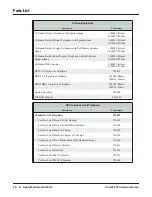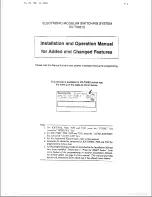
Feature Description
34
XBLUE Networks
3
Cal
l F
orw
ar
d
Call
ȱ
Forward
At default, all extensions are forwarded to voicemail. However, they can also use several other types of call
forwarding; Busy, Direct, Do Not Disturb, Follow me, Call forking, and Remote (External). These can be
programmed using the web interface or by dialing the call forward code.
Busy Call Forward
Busy Call Forward, forwards all incoming calls to the forwarded destination only when the extension is busy.
Extensions that are busy forwarded will not ring when a second call is presented to them. However, an alert tone
is heard indicating that a new call is being routed to the forwarded destination.
Direct (Always) Call Forward
Direct Call Forward, forwards all incoming calls to the forwarded destination as soon as it is presented to the
extension. An alert tone is heard indicating that a new call is being routed to the forwarded destination.
Do not Disturb Call Forward
DND call forward, forwards all incoming calls to the forwarded destination only when the extension is in DND. If
the extension is put into DND and it is not DND forwarding, callers will get a busy signal.
Follow me Forward
The Follow Me Forward, feature allows internal extension users to re-forward their extensions to a new location.
This is especially helpful when waiting for an important telephone call but must go to another destination, such as
an impromptu meeting. An alert tone is heard indicating that a new call is being routed to the forwarded
destination.
Call Forking Forwarding
Call Forking is used to ring two destinations at the same time. This feature will work for two extension number,
without a SIP Trunk, but with a SIP Trunk, it can ring an extension and one or two external numbers.
Remote (External) Call Forward
Remote (External) Call Forward, allows extension users to forward their incoming calls to a remote destination
such as a cellular or home telephone number. The extension user can change their forwarded destination from
their extension.
Call
ȱ
Operator
The system supports both a primary and secondary operator which can be accessed from any SIP telephone
endpoint or the analog port by dialing “0”. Any extension, SIP telephone endpoint or FXS (analog port) can be
assigned as the primary and secondary operator. The Operators are defined in the Numbering Plan.
Call
ȱ
Park
Park often called orbit, is a way of placing a call on hold where anyone within the system can access that call by
dialing a park pickup code. The Park location is usually the same as the extension number.
Summary of Contents for X-50
Page 1: ......
Page 2: ......
Page 8: ...8 XBLUE Networks TOC Notes...
Page 12: ...Notices and Conventions 12 XBLUE Networks 1 Trademarks Notes...
Page 22: ...Introduction 22 XBLUE Networks 2 Things to know about the product Notes...
Page 46: ...Feature Description 46 XBLUE Networks 3 Wizard Setup Notes...
Page 74: ...Telephone Feature Description Table 74 XBLUE Networks 4 Web Management Notes...
Page 84: ...Programming Wizard 84 XBLUE Networks 6 WAN Port Settings...
Page 106: ...Advanced Programming 106 XBLUE Networks 7 Device Information WAN port staticts WAN...
Page 164: ...Wireless Programming 164 XBLUE Networks 8 XBLUE Wireless Universal Adapter Notes...
Page 197: ...XBLUE Networks 199 Voice Internet Gateway Group Voice Network 9 Voice Network...
Page 216: ...Voice 218 XBLUE Networks 9 Registered Phones Notes...
Page 227: ...XBLUE Networks 229 Management Time Settings 10 Manual Date and Time Settings...
Page 232: ...Management 234 XBLUE Networks 10 PTC Configuration PTC Configuration...
Page 240: ...Voicemail 242 XBLUE Networks 12 Remote Message Pickup...
Page 242: ...Voicemail 244 XBLUE Networks 12 Voicemail Administration...
















































